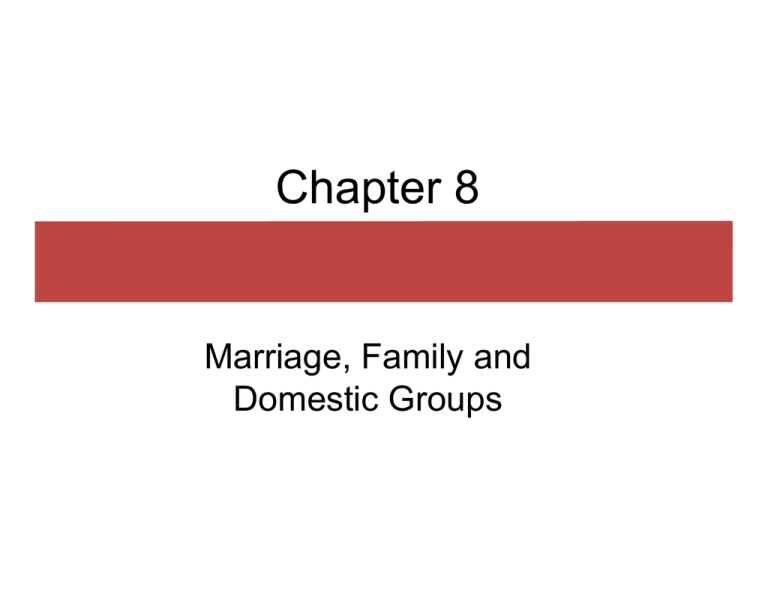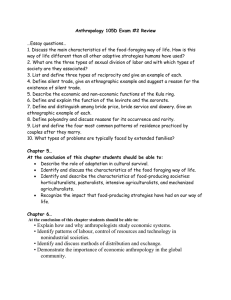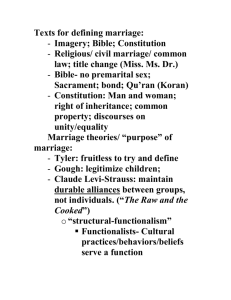
Chapter 8
Marriage, Family and
Domestic Groups
Chapter Outline
Functions of marriage and the family
Are Marriage and the Family Universal?
Marriage Rules
Choosing A Mate
Exchange of Goods and Rights at Marriage
Families, Domestic Groups and Rules of
Residence
Functions of Marriage
Regulates sexual access.
Creates a family.
Expands social group.
Marriage
Customs, rules, and obligations for
relationships between:
A sexually cohabiting man and woman
Parents and children
Families of the bride and groom
Regulate Sexual Access
Reasons:
Limits sexual competition.
Provides stability for children.
Allows for stable economic exchange.
Incest Taboos
Prohibit sexual relations between relatives.
Universal to most cultures.
Exceptions :
– Brother-sister marriages among royalty in
ancient Egypt
– Traditional Hawaiian society
Reasons for Incest Taboo
Avoids inbreeding.
Prevents disruption in the nuclear family.
Directs sexual desires outside the family.
Forces people to marry outside the family and
create a larger social community.
Family Structure
Marriage provides a stable structure:
The male can provide food and
protection.
The female can nurse and nurture the
children.
Expands Social Groups
Links different families and kin groups.
Leads to cooperation beyond the
primary husband-wife pair.
Allows people to share resources.
Benefits the survival of the species.
Exogamy
Rules specifying that a person must marry
outside a particular group.
Almost universal within the primary family
group.
Leads to alliances between different families
and groups.
Endogamy
Rules that marriage must be within a
particular group.
– In India, the caste is an endogamous
group.
– In the U.S., social classes tend to be
endogamous.
Preferential Marriage Rules
Rules about the preferred categories of
relatives for marriage partners:
– Cross cousins
The children of a parent’s siblings of the opposite
sex (mother’s brothers, father’s sisters).
– parallel cousins
• The children of a parent’s same-sex siblings
(mother’s sisters, father’s brothers).
Diagram: Cross Cousins and
Parallel Cousins
Preferential Marriage Rules
Levirate - A man marries widow of a
deceased brother.
Sororate - When a man’s wife dies, her
sister is given to him as a wife.
Question
Customs such as the levirate and sororate support
the notion that
a) marriage is a negotiated alliance between kin
groups rather than between individuals.
b) romantic love is the basis for marriage in most
world societies.
c) children are relatively unimportant as a reason
for getting married.
d) brothers often violently compete with one another
to obtain wives.
e) being a widow or widower is a permanent status
in societies with these customs.
Answer: a
Customs such as the levirate and sororate
support the notion that marriage is a
negotiated alliance between kin groups
rather than between individuals.
Number of Spouses
All societies have rules about how many
spouses a person can have at one time.
Monogamy is the norm only in Europe
and north America.
75% of the world’s societies prefer
plural marriage.
Polygamy
A rule allowing more than one spouse.
Polygyny
– A rule permitting a man to have more than
one wife at a time.
Polyandry
– A rule permitting a woman to have more
than one husband at a time.
Choosing a Mate
In most societies, marriage is important
because it links kin groups of the married
couple.
This accounts for the practice of arranged
marriages.
In the United States, marriage is primarily an
affair of individuals, and the married couple
tends to make a new home apart from the
parents.
Exchange of Goods in Marriage
Three kinds of exchanges made in
connection with marriage are:
– Bride service
– Bridewealth
– Dowry
Bride Service
The husband must work for a specified period
of time for his wife’s family in exchange for his
marital rights.
Occurs mainly in foraging societies, where
accumulating material goods for an exchange
at marriage is difficult.
– Among the Ju/’hoansi a man may work for
his wife’s family for as long as 15 years or
until the birth of the third child.
Bridewealth
The most common form of marriage exchange.
Cash or goods are given by the groom’s kin to the
bride’s kin to seal a marriage.
A major function is to legitimate the new reproductive
and socioeconomic unit created by the marriage.
Bridewealth paid at marriage is returned if a marriage
is terminated.
A person can claim compensation for a violation of
conjugal rights only if the bridewealth has been paid.
Dowry
A presentation of goods by the bride’s kin to the
groom’s family.
Less common than other forms of exchange at
marriage.
Dowry has different meanings and functions in
different societies.
– In some cases it represents a woman’s share of
her family inheritance.
– In other cases it is a payment transferred from the
bride’s family to the groom’s family.
Question
Which statement best summarizes anthropological
thinking on the functions of dowry across the
societies in which this custom is practiced?
a) The dowry is the woman's wealth that she is able
to keep as her own economic security.
b) A dowry is received by the wife's extended family
for their loss of a daughter.
c) Dowry is compensation from the groom's family
since the bride will not inherit from her family.
d) In societies that practice the dowry, it is part of
the process of legitimization of the new alliance
formed by a marriage.
Answer: d
The following statement best summarizes
anthropological thinking on the functions of
dowry across the societies in which this
custom is practiced:
– In societies that practice the dowry, it is
part of the process of legitimization of
the new alliance formed by a marriage.
Types of Families
Anthropologists identify two basic types of
families:
1. Nuclear families are organized around the
conjugal tie, the relationship between
husband and wife
2. The extended family is based on
consanguineal, or blood, relations
extending over three or more generations.
Neolocal Residence
System under which a couple establishes an
independent household after marriage.
Only 5% of the world’s societies are neolocal.
Households
A domestic group, or household, is not the
same as a family.
Households may also include people who
aren’t related.
Changing American Family:
Blended Families
Blended families include previously divorced
spouses and their new partners, children from
previous marriages, and multiple sets of
grandparents and other similar relations.
Almost half of the children of divorced parents
have not seen their biological fathers for more
than a year.
– 10 years later more than 2/3 have lost
contact with him.
Changing American Family:
Single-Parent Families
Single-mother families now account for almost 22%
of all households with children - more than double the
proportion of a generation ago.
About half the children in the U.S. will spend some of
their childhood in a single-parent family.
Single-father families now make up almost 6% of all
households with children and approximately 20%
percent of all single parent households.
Single-mothers and Singlefathers
A 2000 census study found single fathers
were 72% more likely to have a woman
residing with them than a single mother was
to have a man residing with her.
The median income for custodial fathers is
approximately $35,000.
The median income for single mothers is
$21,000 annually, which includes child
support payments.
Composite Family
Aggregates of nuclear families linked by a
common spouse.
– Example: Polygynous household
consisting of one man with several wives.
Most composite families are patrilocal, a
system under which a bride lives with her
husband’s family after marriage.
Extended Family
Blood relations extending over three or more
generations.
Economic advantages: keeps land intact and
provides security in times of crisis.
Provides a sense of participation and dignity
for the older family members.
Extended Family
Extended families may be patrilineal or
matrilineal.
A patrilineal extended family is organized
around a man, his sons, and the sons’ wives
and children.
A matrilineal family is organized around a
woman and her daughters and the daughters’
husbands and children.
Rules of Residence
Patrilocal residence - a woman lives with her
husband’s family after marriage.
Matrilocal residence - a man lives in the household
of his wife’s family.
Avunculocal residence - a married couple is
expected to live with the husband’s mother’s brother.
If a couple can choose between living with either the
wife’s or the husband’s family, the pattern is called
bilocal residence.
Quick Quiz
1. Explanations regarding the function of familial incest
taboos include all except which of the following:
a) This restriction forces people to make alliances
with other families, expanding societal links.
b) Freud's idea was that such a taboo prevents
disruption and conflict within the family.
c) Taboos prohibiting mating between closelyrelated individuals arose because of the higher
incidence of deleterious traits.
d) Incest taboos restrict the known damaging
consequences of inbreeding between parent and
offspring and between siblings.
Answer: c
Explanations regarding the function of
familial incest taboos don’t include the
following:
– Taboos prohibiting mating between
closely-related individuals arose
because of the higher incidence of
deleterious traits.
2. Hypothetical case example: A young husband had an
unfortunate encounter with a crocodile as he was
herding his cows along the banks of the Nile River.
As custom dictated, his brother subsequently
married the bereaved widow, adding her to his
polygynous household. This would be an example of
a) the sororate.
b) the practice of bride-service.
c) the levirate.
d) an arranged marriage.
e) sororal polygyny.
Answer: c
Hypothetical case example: A young
husband had an unfortunate encounter with
a crocodile as he was herding his cows
along the banks of the Nile River. As custom
dictated, his brother subsequently married
the bereaved widow, adding her to his
polygynous household. This would be an
example of the levirate.
3. Which of the following does not describe
contemporary patterns and/or ideals regarding the
American family?
a) a high divorce rate and the associated pattern
social scientists call "serial monogamy"
b) changing household composition, from a nuclear
family to more single-parent households
c) emphasis on romantic love as the basis for the
emotional bond between husband and wife
d) during the past two decades, a significant decline
in households headed by single parents, who are
usually women
e) an ideal shared by most Americans is that of a
nuclear family with a neolocal residence pattern
Answer: d
The following does not describe
contemporary patterns and/or ideals
regarding the American family:
– during the past two decades, a
significant decline in households
headed by single parents, who are
usually women.
4. Persons related by "blood" as opposed to
marriage are known as one's
a) siblings.
b) parallel cousins.
c) consanguines.
d) affines.
e) domestic group.
Answer: c
Persons related by "blood" as opposed to
marriage are known as one's
consanguines.







